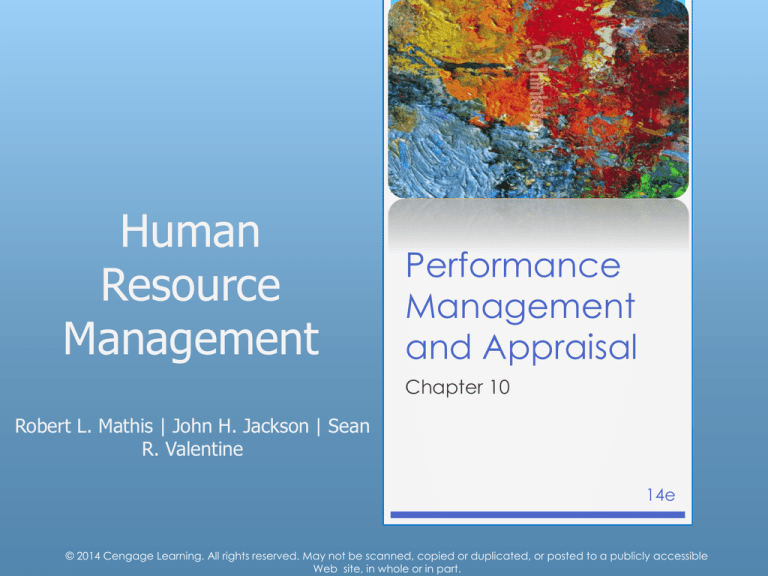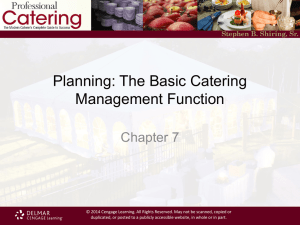
Human
Resource
Management
Performance
Management
and Appraisal
Chapter 10
Robert L. Mathis | John H. Jackson | Sean
R. Valentine
14e
© 2014 Cengage Learning. All rights reserved. May not be scanned, copied or duplicated, or posted to a publicly accessible
Web site, in whole or in part.
Performance Management versus
Performance Appraisal
© 2014 Cengage Learning. All rights reserved. May not be scanned, copied or duplicated, or posted to a publicly accessible
Web site, in whole or in part.
The Nature of Performance
Management
© 2014 Cengage Learning. All rights reserved. May not be scanned, copied or duplicated, or posted to a publicly accessible
Web site, in whole or in part.
Figure 10.2 - Components of a
Performance-Focused Culture
© 2014 Cengage Learning. All rights reserved. May not be scanned, copied or duplicated, or posted to a publicly accessible
Web site, in whole or in part.
Identifying and Measuring Employee
Performance
© 2014 Cengage Learning. All rights reserved. May not be scanned, copied or duplicated, or posted to a publicly accessible
Web site, in whole or in part.
Figure 10.3 - Types of Performance
Information
© 2014 Cengage Learning. All rights reserved. May not be scanned, copied or duplicated, or posted to a publicly accessible
Web site, in whole or in part.
Performance Standards
Define
the expected levels of employee
performance
Should
be realistic, measurable, and clearly
understood
Benefit both organizations and employees
Ensure
that everyone involved knows the
levels of accomplishment expected
Can
be both numerical and non-numerical
Assessing non numerical standards can be difficult
© 2014 Cengage Learning. All rights reserved. May not be scanned, copied or duplicated, or posted to a publicly accessible
Web site, in whole or in part.
Figure 10.4 - ACTFL Performance
Standards for Speaking Proficiency
© 2014 Cengage Learning. All rights reserved. May not be scanned, copied or duplicated, or posted to a publicly accessible
Web site, in whole or in part.
Difficulties in Measuring Service
Performance
© 2014 Cengage Learning. All rights reserved. May not be scanned, copied or duplicated, or posted to a publicly accessible
Web site, in whole or in part.
Performance Appraisals
Assess
an employee’s performance
Provide
Help
a platform for feedback
administering wages and salaries
Help
identifying individual employee
strengths and weaknesses
Provide
Help
answers to work-related questions
improve job performance
© 2014 Cengage Learning. All rights reserved. May not be scanned, copied or duplicated, or posted to a publicly accessible
Web site, in whole or in part.
Figure 10.5 - Uses for Performance
Appraisals
© 2014 Cengage Learning. All rights reserved. May not be scanned, copied or duplicated, or posted to a publicly accessible
Web site, in whole or in part.
Decisions About the Performance
Appraisal Process
Designing Appraisal Systems
Appraisal
Responsibilitie
s
Informal vs.
Systematic
Processes
Timing of
Appraisals
© 2014 Cengage Learning. All rights reserved. May not be scanned, copied or duplicated, or posted to a publicly accessible
Web site, in whole or in part.
Figure 10.6 - Typical Division of HR
Responsibilities: Performance Appraisal
© 2014 Cengage Learning. All rights reserved. May not be scanned, copied or duplicated, or posted to a publicly accessible
Web site, in whole or in part.
Who Conducts Appraisals?
Supervisors rating
their employees
Multisource or
360° feedback
Sources of
Performance
Appraisals
Outside sources
rating employees
Employees rating
their superiors
Team members
rating each other
Employees rating
themselves
© 2014 Cengage Learning. All rights reserved. May not be scanned, copied or duplicated, or posted to a publicly accessible
Web site, in whole or in part.
Figure 10.7 - Multisource Appraisal
© 2014 Cengage Learning. All rights reserved. May not be scanned, copied or duplicated, or posted to a publicly accessible
Web site, in whole or in part.
Category Scaling Methods
Graphic
rating scale: Allows the rater to mark
an employee’s performance on a continuum
indicating low to high levels of a particular
characteristic
10–16
© 2014 Cengage Learning. All rights reserved. May not be scanned, copied or duplicated, or posted to a publicly accessible
Web site, in whole or in part.
Category Scaling Methods
Aspects of Performance
Measured
Descriptive
Categories
Job
Duties
Behavioral
Dimensions
10–17
© 2014 Cengage Learning. All rights reserved. May not be scanned, copied or duplicated, or posted to a publicly accessible
Web site, in whole or in part.
Category Scaling Methods
Behaviorally
Anchored Rating Scale (BARS)
Composed of job dimensions (specific descriptions
of important job behaviors) that anchor
performance levels on the scale
Developing
a BARS
Identify important job dimensions
Write short statements of job behaviors
Assign statements (anchors) to job dimensions
Set scales for anchors
© 2014 Cengage Learning. All rights reserved. May not be scanned, copied or duplicated, or posted to a publicly accessible
Web site, in whole or in part.
Figure 10.10 - Behaviorally-Anchored
Rating Scale for Customer Service Skills
© 2014 Cengage Learning. All rights reserved. May not be scanned, copied or duplicated, or posted to a publicly accessible
Web site, in whole or in part.
Comparative Methods
Ranking:
Listing of all employees from highest
to lowest in performance
Drawbacks
Does
not show size of differences in performance
between employees
Implies
that lowest-ranked employees are
unsatisfactory performers
Becomes
an unwieldy process if the group to be
ranked is large
© 2014 Cengage Learning. All rights reserved. May not be scanned, copied or duplicated, or posted to a publicly accessible
Web site, in whole or in part.
Comparative Methods
Forced
distribution: Causes ratings of
employees to be distributed along a bellshaped curve
© 2014 Cengage Learning. All rights reserved. May not be scanned, copied or duplicated, or posted to a publicly accessible
Web site, in whole or in part.
Forced Distribution
Advantages
Disadvantages
• Helps deal with “rater inflation”
• Managers resist placing people in
the lowest or highest groups
• Explanation for placement can be
difficult
• Performance may not follow
normal distribution
• Managers may make false
distinctions between employees
• Makes manages identify high,
average, and low performers
• Ensures that compensation
increases reflect performance
differences among individuals
© 2014 Cengage Learning. All rights reserved. May not be scanned, copied or duplicated, or posted to a publicly accessible
Web site, in whole or in part.
Figure 10.11 - Forced Distribution on a
Bell-Shaped Curve
© 2014 Cengage Learning. All rights reserved. May not be scanned, copied or duplicated, or posted to a publicly accessible
Web site, in whole or in part.
Narrative Methods
Critical
incident - Manager keeps a written
record of highly favorable and unfavorable
employee actions
Drawbacks
Variations
Time
in how managers define a critical incident
involved in documenting employee actions
Most
employee actions are not observed and may
become different if observed
Employee
concerns about manager’s black books
© 2014 Cengage Learning. All rights reserved. May not be scanned, copied or duplicated, or posted to a publicly accessible
Web site, in whole or in part.
Narrative Methods
Essay
- Manager writes a short essay
describing an employee’s performance
Drawback - Depends on the supervisors’ writing skills
and their ability to express themselves
© 2014 Cengage Learning. All rights reserved. May not be scanned, copied or duplicated, or posted to a publicly accessible
Web site, in whole or in part.
Management by Objectives (MBO)
Management
by objectives: Performance
appraisal method that specifies the
performance goals that an individual and
manager identify together
© 2014 Cengage Learning. All rights reserved. May not be scanned, copied or duplicated, or posted to a publicly accessible
Web site, in whole or in part.
Stages in the MBO Process
1. Job review and
agreement
2. Development of
performance standards
3. Setting of objectives
4. Continuing performance
discussions
© 2014 Cengage Learning. All rights reserved. May not be scanned, copied or duplicated, or posted to a publicly accessible
Web site, in whole or in part.
Training Of Managers And Employees
in Performance Appraisal
© 2014 Cengage Learning. All rights reserved. May not be scanned, copied or duplicated, or posted to a publicly accessible
Web site, in whole or in part.
Types of Rater Errors
Varying
standards
Recency
Central
errors
Rater
Halo
and primacy effects
tendency, leniency, and strictness
bias
and horns effects
Contrast
error
Similar-to-me/different-from-me
errors
© 2014 Cengage Learning. All rights reserved. May not be scanned, copied or duplicated, or posted to a publicly accessible
Web site, in whole or in part.
Effective Performance Management
Consistent with the
strategic mission
Effectively
documents
performance
Effective
Performance
Management
System
Viewed as fair by
employees
Beneficial as a
development tool
Useful as an
administrative tool
Is legal and job
related
© 2014 Cengage Learning. All rights reserved. May not be scanned, copied or duplicated, or posted to a publicly accessible
Web site, in whole or in part.







